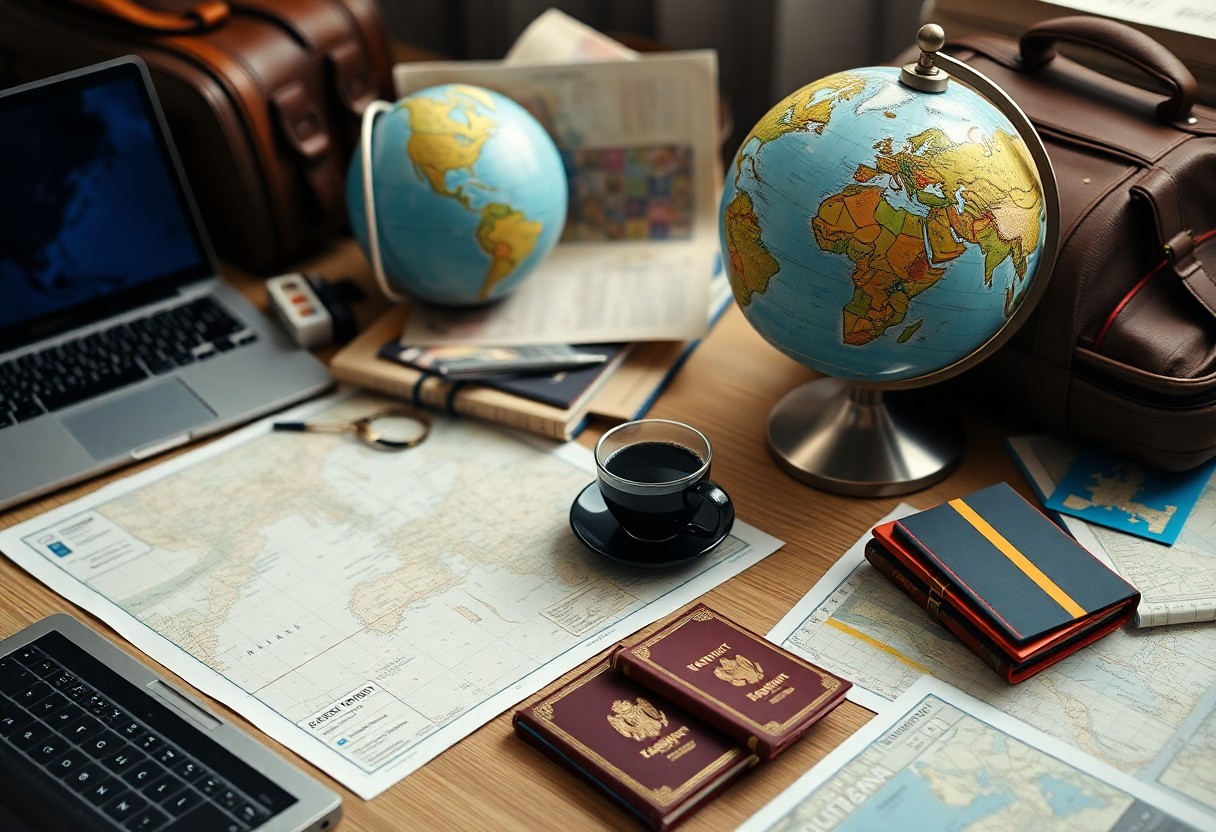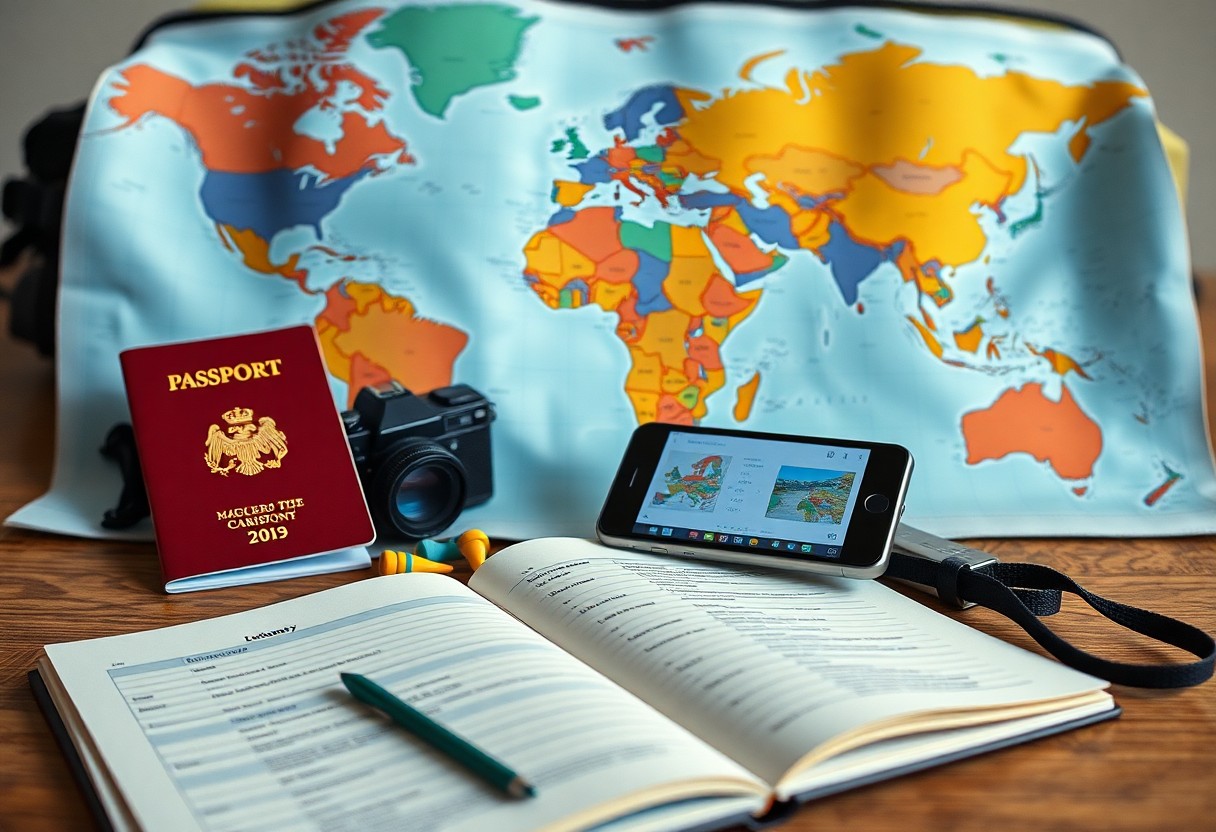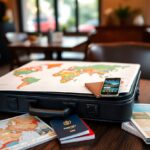
It’s easy to feel overwhelmed when organizing a multi-country trip, but with the right approach, you can streamline the process and enjoy your journey fully. By carefully mapping out your itinerary, coordinating transportation, and managing accommodations, you can prevent common pitfalls and stay stress-free. You’ll discover practical tips to optimize travel routes, handle visa requirements, and balance sightseeing with downtime, ensuring a smooth and rewarding travel experience every step of the way.
Key Takeaways:
- Research and outline the main destinations you want to visit, focusing on logistics such as distance, visa requirements, and local transportation.
- Create a flexible itinerary that allows for unexpected changes and includes buffer days between major travel segments to reduce stress.
- Prioritize booking accommodations and major transportation in advance to secure the best options and rates.
- Pack light and smart, considering the climates and activities planned for each country to avoid overpacking and complications.
- Use digital tools and apps to organize bookings, confirmations, and important documents in one accessible place throughout your journey.
Route Planning Tools
Before you commence on your multi-country adventure, choosing the right route planning tools can save you time and stress. The right apps and websites help you visualize your journey, estimate travel times, and coordinate connections smoothly. With so many options available, selecting tools that fit your travel style and provide reliable information will keep your itinerary organized and manageable.
Utilizing Google Maps
Any traveler planning a multi-country trip benefits from Google Maps’ versatility. You can view detailed maps, check transit routes, and explore landmarks. It allows you to save locations, build custom maps, and get real-time navigation, making it easier to coordinate complex routes between cities and countries.
Exploring Rome2Rio
Maps on Rome2Rio simplify the challenge of figuring out multi-modal transportation options. It offers comprehensive details on flights, trains, buses, ferries, and driving routes, all in one place. This helps you compare travel times and costs efficiently.
At its core, Rome2Rio is designed to give you a clear picture of how to get from one destination to another, no matter where you are in the world. You can explore different transport combinations and make informed decisions that align with your budget and schedule, which is especially helpful when planning complex, multi-country routes.
Visa and Vaccination Information
While planning your multi-country trip, gather all visa and vaccination details early to avoid last-minute surprises. Each country has distinct entry regulations and health requirements, so verifying them in advance is crucial. Stay organized by creating a checklist for each destination’s necessary documents and health preparations, ensuring a smooth journey without unexpected interruptions.
Country-Specific Requirements
Between different nations, visa rules and vaccination mandates can vary widely. Some countries require advance visa applications, while others offer visa-on-arrival or e-visas. Likewise, vaccination requirements such as yellow fever proof or COVID-19 certifications differ per destination. Research these specifics thoroughly to align your travel plans with official entry guidelines.
Regional Health Precautions
Behind the ease of travel, certain regions pose health risks requiring specific precautions. Malaria zones, areas with recent outbreaks, or seasonal health threats may influence your vaccination needs and protective measures. Understanding these regional health factors helps you prepare effectively and maintain your well-being throughout your trip.
At the core of managing health precautions is your proactive approach to gathering up-to-date information from reliable sources like health ministries or travel clinics. You can consult professionals about recommended vaccinations, preventive medications, and safety practices tailored to your itinerary. By staying informed, you’ll ensure your health decisions complement your travel plans and keep your journey safe and enjoyable.
Budgeting and Currency Preparation
Despite the excitement of planning a multi-country trip, managing your budget and currency exchange is key to a smooth experience. Without a clear financial plan, costs can quickly spiral out of control. By carefully preparing your budget and understanding currency options, you maintain control over your spending and avoid unexpected expenses. This groundwork helps you maximize your travel funds and focus on enjoying each destination without financial stress.
Estimating Travel Costs
Preparation for your trip begins with estimating travel costs accurately. You’ll want to account for transportation, accommodation, meals, activities, and incidentals in each country you visit. Researching average prices and building a flexible budget allows you to anticipate expenses realistically. Planning ahead ensures you allocate funds sensibly, leaving room for spontaneous experiences while keeping your overall budget intact.
Currency Exchange Options
Behind the scenes of your trip planning is the need to navigate currency exchange wisely. You’ll encounter various options including exchange bureaus, banks, credit cards, and prepaid travel cards. Each has its own fees and exchange rates that can impact your spending power abroad. Understanding the benefits and drawbacks of each option helps you decide how best to manage your money across different currencies.
Hence, when considering currency exchange options, factor in convenience, cost, and security. Using a combination of cards and some local cash often provides the best balance. Avoid exchanging large amounts at airports or tourist hotspots where rates can be unfavorable. Instead, look for reputable providers or withdraw cash from local ATMs after arriving. By planning your currency strategy carefully, you reduce hassle and get more value from your money during your multi-country adventure.
Managing Bookings and Timelines
Your ability to keep track of flights, accommodations, and activities across multiple countries hinges on effective organization. Establish clear timelines and stay updated on confirmation details to avoid last-minute stress. Use digital tools to synchronize your schedule and set reminders for check-ins and deadlines, ensuring every segment of your trip unfolds seamlessly.
Booking Accommodations
Along with selecting convenient locations, focus on flexible booking options that allow changes without hefty penalties. Prioritize accommodations that offer clear cancellation policies and instant confirmation to keep your plans fluid. Keeping a record of all bookings in one accessible place strengthens control and confidence as you navigate through different destinations.
Creating a Travel Itinerary
Any well-rounded itinerary balances sightseeing, travel time, and rest. Outline daily activities with estimated durations and transit times. Incorporate buffer periods to accommodate unexpected delays or spontaneous discoveries. A thoughtfully crafted itinerary gives you structure without sacrificing the chance for discovery.
Bookings form the backbone of your travel itinerary. As you confirm each reservation—from flights to tours—integrate them into a centralized, easily retrievable document or app. This consolidated itinerary should include contact details, addresses, and reservation numbers. By having this information at your fingertips, you sustain momentum and maintain peace of mind throughout your journey.
Packing Considerations
Many travelers underestimate the importance of smart packing for a multi-country trip. You need to balance carrying enough importants with staying light for easy mobility. Organizing your luggage by categories and using packing cubes can save space and keep you efficient. Prioritize versatile clothing and plan for various activities and climates to avoid unnecessary items. Preparing this way helps maintain your sanity and ensures you’re ready for each destination without the burden of overpacking.
Essential Items to Bring
Across diverse cultures and destinations, certain importants must always be in your bag. These include your passport, travel insurance, a reliable charger, and versatile power adapters. Comfortable walking shoes, a compact first aid kit, and refillable water bottles also improve your travel experience. Packing lightweight layers and quick-dry fabrics will keep you comfortable and agile. Carrying a printed copy of important documents and a secure travel wallet helps keep your valuables organized and easily accessible throughout your journey.
Adapting to Different Climates
Between countries, the climate can vary dramatically, requiring thoughtful clothing choices. You should include transitional layers like lightweight jackets and moisture-wicking shirts that can be added or removed as temperatures fluctuate. Selecting breathable fabrics helps manage heat, while a compact raincoat or umbrella prepares you for unexpected weather changes. This adaptability in your wardrobe will keep you comfortable and prepared, eliminating the stress of unpredictable conditions during your adventure.
Another effective strategy for managing multiple climates is packing items with multiple uses, such as scarves that provide warmth and sun protection or convertible pants that switch between shorts and long pants. Consider footwear that suits a variety of terrains and weather, like waterproof walking shoes. By planning outfits around core pieces tailored to various environments, you streamline your luggage and ensure you can handle any weather changes without hassle.
Insurance Considerations
All savvy travelers recognize that insurance is a vital element of planning a multi-country trip. Without proper insurance, you risk incurring unexpected expenses from medical emergencies, trip interruptions, or lost belongings. Ensuring you have the right coverage gives you peace of mind and protection no matter where you go. Assess your itinerary and personal needs carefully to choose the policies that best match your travel style.
Types of Travel Insurance
An understanding of travel insurance types helps you make informed choices. Here are common categories:
- Medical Coverage – Covers hospitalization and emergency treatment abroad.
- Trip Cancellation – Reimburses prepaid expenses if you cancel for covered reasons.
- Baggage Loss – Protects against lost, stolen, or damaged luggage.
- Travel Delay – Provides compensation for delayed flights or missed connections.
- Evacuation Coverage – Pays for emergency medical transport if needed during your trip.
| Type | Description |
|---|---|
| Medical Coverage | Emergency and routine medical care abroad |
| Trip Cancellation | Refund for non-refundable trip costs if cancelled |
| Baggage Loss | Compensation for lost or stolen luggage |
| Travel Delay | Benefits for delayed flights or accommodations |
| Evacuation Coverage | Emergency medical transport expenses |
The key is matching these options with your specific trip risks and concerns.
Understanding Coverage Needs
Understanding your priorities helps you decide what insurance to purchase. Factors like your health status, destinations, activities planned, and length of stay influence your coverage needs. Some countries require proof of insurance before entry, while others have limited medical facilities, increasing the importance of evacuation coverage. Make sure any pre-existing conditions or adventure sports are included if applicable.
This assessment ensures you are financially protected from incidents that could disrupt your journey or cause high out-of-pocket expenses. By meticulously checking policy details and exclusions, you can confidently travel knowing your insurance aligns with your unique itinerary and comfort level.
Final Words
Ultimately, planning a multi-country trip requires organization and flexibility to ensure your journey is enjoyable and stress-free. By researching destinations, creating a realistic itinerary, and preparing necessary documents in advance, you can streamline your travel experience. Stay open to adjustments and embrace the unexpected, as this will enhance your adventure and help you make the most of each location. With thoughtful preparation, your multi-country trip can become a memorable exploration that broadens your horizons without overwhelming you.
FAQ
Q: How do I start planning a multi-country trip effectively?
A: Begin by selecting the countries you’d like to visit and researching the best times to travel to each. Consider visa requirements, climate, and cultural events. Map out a rough itinerary that allows adequate time in each destination without feeling rushed. Prioritize destinations based on your interests and travel logistics to create a manageable flow.
Q: What are some strategies to keep travel logistics organized across multiple countries?
A: Use a dedicated travel planner app or spreadsheet to track your flights, accommodation bookings, transport connections, and important documents. Keep digital backups of your passport, tickets, and reservations. Organize all confirmations and tickets in chronological order to easily access them when needed during your trip.
Q: How can I manage budget planning for a trip involving several countries?
A: Research the average daily costs for each country, including accommodation, food, transport, and activities. Set a realistic daily budget and adjust spending based on the cost variations between countries. Use a travel budgeting app to monitor expenses in real-time and convert currencies ahead of time to avoid surprises.
Q: What tips can help reduce travel fatigue during a multi-country trip?
A: Plan for slower transit days or include rest days between busy travel schedules. Pack light and smart to avoid carrying heavy luggage. Stay hydrated and try to maintain a good sleep routine. Choosing overnight trains or flights can also save daytime hours and reduce accommodation costs, helping you maximize rest and exploration.
Q: How do I stay safe and healthy when traveling through multiple countries?
A: Research health advisories and vaccinations needed for each destination prior to departure. Carry a basic first aid kit and any imperative medications. Stay aware of local customs and laws to avoid misunderstandings, and keep your valuables secure at all times. Maintain good hygiene practices and be cautious about food and water sources to prevent illness.




